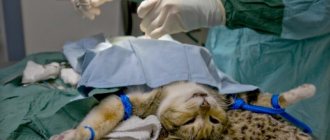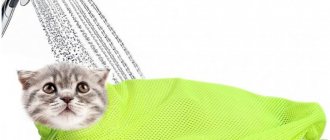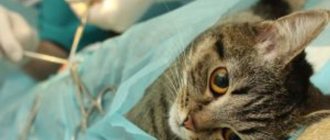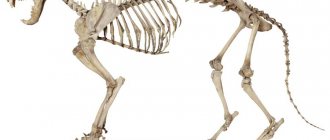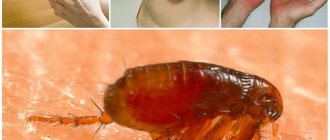In recent years, cats with pathological conditions of the urinary system are increasingly being admitted to the veterinary clinic. The largest share of diseases occurs due to inflammation of the lower urinary tract, which over time becomes chronic.
In advanced cases with complete obstruction of the urethra and the development of complications, only surgical treatment or urethrostomy can be an effective solution to the problem.
Urethrostomy in cats is a surgical treatment aimed at creating a new urethral opening. Surgical intervention allows you to obtain a significantly shortened, straight urethra, which facilitates the passage of small stones and sand. As a result of the operation, blockage of the urethra is prevented, and urination in the cat becomes almost painless.
Urethrostomy
This operation, as a result of which the animal has a new opening for urination, located between the peritoneum and the wide part of the urethra. In recent years, it has been less and less possible to bring the situation to surgical intervention, since many drugs have appeared that can prevent the process of blocking the canal. The correct diet and information that owners of animals with urolithiasis should have at their disposal make it possible to avoid surgical intervention.
Indications
Urethrostomy in cats is prescribed by the attending physician in cases where other methods of solving the problem do not give positive results. In addition, obstruction of the distal part of the urethra may be irreparable, which is why it is necessary to resort to surgery. The urethra is a channel through which urine is removed from the body. Its structure in cats is characterized by uneven width. As it approaches the urethra it becomes thinner. Most often, this is where the blockage occurs. In most cases, the plug consists of salts or blood cells, which is explained either by urolithiasis or cystitis. Sometimes obstruction is the result of injury, inflammation or tumors.
Perineal urethrostomy in cats can accelerate the development of urinary tract infections. It is for this reason that experts prefer to carry out conservative treatment first and only if it does not help, they resort to surgical intervention.
There are doctors who do their best to avoid such intervention due to complications. Urethrostomy in cats, reviews of which from specialists are very contradictory, can result in stoma closure - partial or complete.
Most complications arise from too much stress on the sutures of the mucosa during the healing process. Often connective tissue grows in the hole created during surgery.
It is quite difficult to eliminate consequences of this kind; it is even more likely that the condition of the animal itself will deteriorate due to the exacerbation of concomitant diseases. The attitude of the owners also plays an important role in the course of recovery - most often they behave rather inertly and pessimistically.
Technique for urethrostomy surgery in a cat
The purpose of the operation is to create an opening (stoma) for the constant independent release of urine. This can be done in two ways:
Perineal urethrostomy
As the name suggests, the hole is formed in the area between the anus and the scrotum. The anus or anus is the end of the digestive system, the place where waste products are removed from the body, located under the tail. The scrotum is a skin-muscular sac that contains the testes.
During the operation, the penis and testes are removed. Amputation of the penis is important because it has two narrowings of the canal. A catheter is inserted into the resulting stoma, with one end located in the urethra and the other extending beyond the abdominal wall. As a result of urethrostomy, the urogenital canal becomes shorter but wider, so sand and stones up to 5 mm in size can be freely passed through the urine.
Prepubal urethrostomy
It is performed for various pathologies in the pelvic area, injuries to the urethra, if the use of perineal access is impossible. To do this, the surgeon makes an incision in the abdominal wall in the area of the pubic fusion, the bladder is cleared of urine by a puncture, and the damaged part of the urethra is removed. A wide channel coming from the bladder is brought to the incision site and sutured to the abdominal wall.
As a result of urethrostomy, urination in cats occurs in the same way as in females, but constantly, since there is no longer a muscular valve - the sphincter - at the outlet of the canal.
Preparing for surgery
Owners of almost all animals for which urethrostomy in cats is recommended have observed problems with urination. Such disorders contribute to the development of renal failure, most often in acute form. It is very important to identify this situation and correct it before surgery. Sometimes catheterization during surgery is impossible, so you have to resort to cystocentesis - draining urine from the punctured bladder through the abdominal wall.
If inflammation of the urinary system lasts for a long time, the development of sepsis and anemia is likely, which, of course, requires timely diagnosis and optimization. Urethrostomy in cats requires the following tests:
— Ultrasound of the abdominal cavity.
— General analysis of urine and blood.
— Blood test for biochemistry.
— Contrast radiography of the urinary system.
If other diseases are detected, additional tests may be required.
What is an obstruction or blockage?
A large number of cats suffer from blocked urinary tract. Usually, even with its obvious symptoms, veterinarians make a diagnosis of ICD in a cat. This plug, which appears in the urethra, may occur due to the fact that sandy mass and various stones or mucus have accumulated there.
Stones that form in the urinary organs have a varied toxic composition of chemical elements. Quite a lot of them can form. They are also completely different in shape.
The essence of the operation
Urethrostomy in cats, the consequences of which can be quite serious, requires a clear understanding by the owner of every step from diagnosing the disease to the complete recovery of the animal. The purpose of the operation is to remove the problematic part of the urethra. Most often this is the area from the penis bone. A short urethra simplifies the process of urination, especially when the bladder is incompletely emptied for a long time, leading to overstretching of its walls. The diameter of the urethra in the pelvic region of the urinary canal is quite wide, which makes it possible to practically eliminate re-occlusion.
Progress of the operation
How complex or simple the cat’s surgery will be depends on various pathologies. Urethrostomy, accompanied by urolithiasis, which is the most common case, requires a control ultrasound before surgery and radiography, which makes it possible to clarify the final position of the stones and their exact number. After this, the urethra is washed and the bladder is catheterized. If the cat previously retained the reproductive function, castration is performed. The next step is urethrostomy in the cat. The operation involves suturing a part of the urethra, which has a wide diameter, to the skin. The penis is completely removed.
Briefly, this is how urethrostomy is performed in a cat. The course of the operation may vary somewhat depending on the physical characteristics of the animal and concomitant diseases. In general, under epidural and inhalation anesthesia, the operation ends in 25-45 minutes.
Causes and types of disease
The following reasons contribute to the development of the disease:
- Living conditions. When living in a hot climate, the animal's urine becomes more concentrated. This is due to impaired filtration of primary urine.
- Geochemistry. The composition of drinking water, air and soil affects the health of the pet. Drinking water containing lime salts increases the acidity of urine. In this case, calcium salts accumulate in the cat’s kidneys and bladder, from which stones and sand are formed.
- Poor nutrition. The more protein-rich food a cat eats, the more urea is excreted in the urine. A complete lack of proteins can also lead to the development of urolithiasis.
- Lack of vitamins. A deficiency of retinol, found in vegetable oils, eggs, herbs and some vegetables, negatively affects kidney function.
- Diseases of the endocrine system. When the parathyroid glands produce excess hormones, the concentration of calcium in the blood increases. The substance is excreted by the kidneys, part of the calcium forms insoluble salts.
- Anatomical features. The cat's urethra has several narrow areas in which sand is retained.
- Diseases of the digestive system. Inflammatory processes in the mucous membranes of the stomach and intestines lead to increased acidity of urine.
- Infections. Tissues affected by viruses and bacteria become nuclei for crystal deposition.
With urolithiasis in cats, deposits of 2 types can form:
- struvite (phosphate stones are found in 80% of animals suffering from urolithiasis);
- oxalates (stones consisting of oxalic acid salts are detected in older cats).
Reconstruction of a strictured urethra
Sometimes, fortunately not often, urethral rupture and stricture occur. This can be caused by necrosis, excessive pressure on the penis during surgery, catheterization, during which injury was caused.
Damage can also occur as a result of external trauma. If the problem appears caudal to the prostate, urethrostomy in cats, the consequences of which can be more dangerous than the disease itself, can be performed. To correct the pathology, it is necessary to use a prepubic urethrostomy to the right and below the pelvis. Partial tears are sutured if the nearby tissue is alive. In case of violation of the proximal urethra, we are talking about a cystoma or anastomosis. Unfortunately, both of these procedures are not an ideal solution: the installation of a cystoma leads to incontinence, while the anastomosis causes various acid-base or electrolyte abnormalities.
Prevention of ICD
Prevention of the disease in cats includes drinking enough fluid, proper nutrition, and weight correction. The diet should meet the body's needs for vitamins and nutrients and not cause constipation. Maintaining normal room temperature helps restore daily diuresis.
All information posted on the site is provided in accordance with the User Agreement and is not a direct instruction to action. We strongly recommend that before using any product, you must obtain a face-to-face consultation at an accredited veterinary clinic.
Early complications
Urethrostomy in cats, reviews of which make you seriously fear for your pet, is sometimes fraught with various complications.
This may be primarily bleeding. It is minimized by including the penis cavity in the urethral sutures. If bleeding occurs, the specialist applies pressure to the injection site, which often stops the bleeding. Most often, this is a non-life-threatening event that does not require repeated surgical intervention. The color of the mucous membranes and the measurement of hematocrit make it possible to determine the degree of bleeding. If it is constant and strong, its location is determined and it is ligated under anesthesia.
In very rare cases, a cat may show symptoms of anuria after urethrostomy surgery. It occurs in cases where urine has not been excreted for more than two days. The likelihood of a complication increases with every hour that exceeds this period.
Acute renal failure develops in cases where, even before the intervention, the animal experienced an enlargement of this organ. The second option is if the cat spent a long time in a state of hypotension and dehydration. A urine test will help determine the presence of pathology. The specific density gives a greater likelihood of prerenal causes of insufficiency. Based on the results, treatment will be carried out aimed at eliminating hypovolemia, hypotension and dehydration.
What could be the consequences?
- Bleeding. Minor bleeding, as a rule, does not threaten the health and life of your pet. In case of heavy bleeding, surgery is not required.
- Urinary dysfunction. It is important to understand that surgery cannot completely cure the pathology of the urinary system. Therefore, the likelihood of dysuria is high. The main causes of urinary problems may be the presence of bacteria, sand and small stones in the urine.
- Seams coming apart. After urethrostomy, the animal may develop swelling and redness of the perineum. These symptoms most often appear due to urine entering the subcutaneous space, which can result in the sutures coming apart. In this case, repeated surgical treatment may be required.
- Anuria. After surgery, cats may not urinate for 24 hours. This phenomenon is considered normal if they were not fed after treatment. But you should be wary if urine is not released from the bladder for more than two days.
- Narrowing of the urethra (stricture). The most common consequence may be overgrowth of the urethra due to the formation of tears in the urinary canal during catheterization of a sick animal. In this case, a repeat procedure may be required.
- Purulent inflammation. If the operation was performed by a veterinarian using unsterile instruments, there is a risk of infection. In addition, consequences in the form of abscess formation can occur due to the unprofessionalism of the veterinarian who damaged the rectum during surgery.
Late complications
The list of late complications that can arise after surgery is much wider and includes not only accidental pathologies, but also oversights or specialist errors.
Recurrent cystitis occurs in a third of cats undergoing surgery. Very often it is asymptomatic, so animals that have undergone the intervention need to have a urine culture every six months.
To identify the causes of such a complication as dysuria, it is necessary to examine the site of intervention as carefully as possible in search of unremoved sutures. The condition of the urethra is assessed by inserting a catheter into the bladder. If sand blockage is observed, it is removed after irrigation with anesthetics. Urine obtained in this way is tested for bacterial culture. If microflora is detected, a course of antibiotic treatment is necessary. The absence of bacteria indicates a possible cause of dysuria - feline urological syndrome. Despite the fact that in most cases, cat urethrostomy surgery, reviews of which make it possible to independently decide on its rationality, prevents obstruction, it cannot eliminate the possibility of relapse of the syndrome. Persistent dysuria requires a contrast-enhanced radiograph to identify other causes of the disease. These could be tumors, stones, etc.
Stricture is observed quite often. This leads to contamination of the seams. According to various sources, this complication occurs in 12% of cases. Stricture progression can be avoided through careful tissue preparation and absolute attention to surgical technique.
Surgical errors leading to stricture:
- Insufficient dissection of the urethra, in which the bulbourethral glands do not extend beyond the skin. In this case, the tension will very likely lead to deepening of the stoma and further stricture. It is to eliminate such a problem that the pelvic ligaments and muscles must be cut to their full thickness.
- Loose contact of the skin with the urethra. In this case, the wound does not heal for a long time, which is due to primary intention. The tissue produced by secondary intention defeats the purpose of the operation, reducing the diameter of the stoma.
- Incorrect stitching technique. If you do not tighten the sutures very carefully and use a cutting needle, areas of excessive granulation are likely to appear, which in the future can completely block the stoma.
In addition, stricture also appears for non-surgical reasons:
— The occurrence of small ruptures of the urethra obtained during catheterization. Blockage of the urethra after several catheterizations is an indication for prepubic urethrostomy.
— Autotomy occurs when the stoma is damaged by an animal that is not wearing a protective collar.
- Stitches. The ends of the sutures must be long enough so that they are easy to detect by the time they are removed. Forgotten sutures can cause suture granulation.
A minor stricture can be corrected by gentle dilatation with a small clamp. However, most often it is necessary to perform additional surgery. In rare cases, when the urethra is severely injured and strictured, a prepubic urethrostomy is performed.
After operation
Rehabilitation of a cat after urethrostomy is a process that requires the help and attention of the owners. In most cases, the animal spends a day in the clinic after surgery. Here they put a special collar on him, which will prevent him from licking the seams. Antibacterial treatment and pain relief medications are required. If there are indications, infusion therapy is performed. Specialists closely monitor the condition of the animal in general and its urination in particular. If doctors do not consider his condition satisfactory, the pet will spend a little more time under observation.
At home
A cat's recovery after surgery takes varying periods of time. This depends on the physical condition of the animal, the prescribed treatment, and the accuracy of following the specialist’s recommendations. Even the owner’s mood affects the speed of the pet’s recovery.
A cat's recovery from a urethrostomy primarily involves wearing a collar at all times, as these animals are especially prone to licking their wounds. Unfortunately, in cases of surgical intervention, this method of “treatment” can only cause harm. Therefore, a collar is required! In addition, it is necessary to regularly clean postoperative sutures and give antibiotics prescribed by the doctor as recommended. This is usually done twice a day. If healing is correct, the sutures are removed after two weeks. If an animal has urolithiasis, it must follow a special diet. Make sure fresh water is always available.
Are there any contraindications?
If cats have uremic syndrome, then urethrostomy is prohibited. Surgery is performed only after the pet's condition has been stabilized with medication. If blockage of the urethra threatens the life of the animal and catheterization cannot be performed, then the contraindication is excluded and surgery is also performed for uremic syndrome. It is important to understand that bladder surgery is quite traumatic, so it should not be performed if the disease can be cured with medications.



